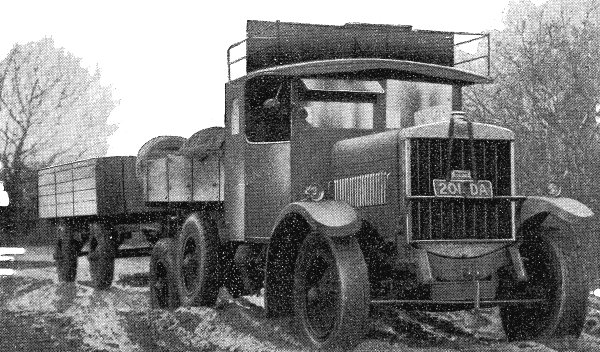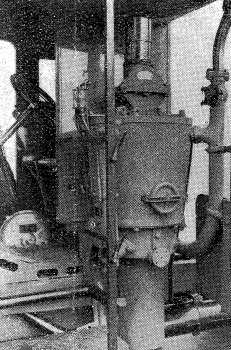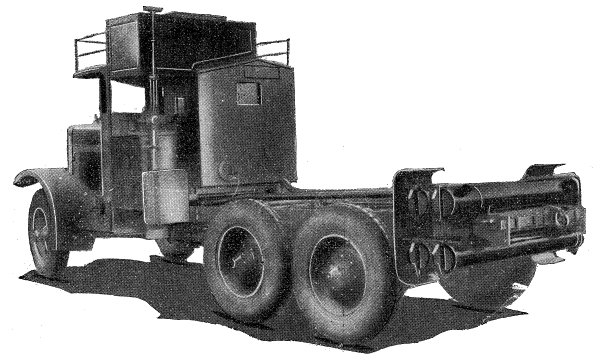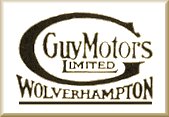|
Running a
Six-Wheeler on Producer Gas
The results of
an instructive test of a Guy lorry equipped with a
Tulloch-Reading Gas Producer
The article is from The Commercial Motor,
January 29th, 1929. Unfortunately the conclusion is missing. |
|
Nowhere in the world is cheap and efficient
transport by road or across country more important than in our
Colonies and Dominions, where main-line railways are usually few
and the distances between them great. The employment of vehicles
running on petrol is often prohibitive, for the reason that the
fuel is so expensive, and, consequently, bulk produce cannot be
handled at an economical figure.
With the advent of the vehicle running on
producer-gas as fuel, the whole outlook has been altered, and
with satisfactory producers using cheap, native-made charcoal,
or, in some cases, even the raw wood, the running costs per
ton-mile can actually be made lower than is normally obtainable
at home. |

A Guy 6-wheeler running on producer gas,
with a laden trailer over soft tracks.
|
Automatic
Producer Required
The great point is to utilize a producer
which is practically automatic in action; so that the vehicles
can be controlled by men having but little skill. The apparatus
must also provide a clean, dry, dust-free gas which will permit
an engine to be run for long periods without decarbonising being
necessary.
When first produced, the main difficulty
was the long time involved in starting from cold, but in the
latest types this annoying factor has been reduced until it is
almost negligible. Similarly, any stops of more than a few
minutes' duration formerly involved an extended blowing-up of
the fire, but here, again, restarting can be made, even after a
stop of half an hour or more, almost with the same ease as in
the case of the engine running on petrol.
As an example of what can be done with a
modern form of producer, we may refer to some particularly
interesting and instructive trials which were recently carried
out with a Guy rigid six-wheeler employing the Tulloch-Reading
gas-producer.
They were run in England under the aegis of
the Empire Cotton Growing Corporation prior to the shipment of
the vehicle to Nigeria, and an independent authority, whose name
we are not at present permitted to divulge, was invited to deal
with the matter.
Tests were carried out on road and
cross-country tracks, with and without a trailer, the weather
conditions being fine during the running on the road, but wet in
general while cross-country work was being done.
To afford a good idea of the behaviour of
the Guy vehicle, it will first be necessary to give a few
details of it. The engine has six cylinders of 4¼ ins. bore and
5½ ins. stroke, giving an R.A.C. rating of 43.3 hp., the gear
ratios being: Top, 1 to 1; third, 1.722 to 1; second, 2.5 to 1;
first 4 to 1; reverse, 3.86 to 1; there was also an auxiliary
gear of 1.985 to 1, whilst the final-drive ratio to the two
axles was 9.33 to 1. The total weight of the lorry was 8 tons 12
cwt., and that of the trailer with its 2 ton load was 3 tons 12
cwt. 1 qr., the total useful load carried and towed being 5
tons.
Conducting
the Tests
Prior to each test, the fuel hopper, water
tank and petrol tank were filled to a definite level. The road
test comprised 202.1 miles with a trailer and 81.5 miles without
a trailer, the lorry being laden with 3 tons for 40.75 miles,
and for an equal distance with 4 tons.
With the trailer the lorry pulled well, and
on the level the maximum speed of 20 mph. was easily attained.
On hills the drag of the trailer made it necessary soon to
change to a lower gear, but it was noticed that by changing down
to first gear early, a hill could be climbed more rapidly than by
remaining in third and second gears for longer periods. It
should be noted that an engine governor was employed, cutting in
at a maximum of 20 mph., but it appeared rather slow in cutting
out, and before acceleration of the engine could be felt again,
the speed would drop to 15 mph. and sometimes even to 12 mph. |

The Tulloch-Reading gas producer, as
fitted to the Guy 6-wheeler. |
Some
Excellent Results
One involuntary stop occurred through an
obstruction in the fuel-feed valve, but to remedy this the whole
valve was removed, cleaned and replaced, and the engine
restarted within 10 minutes. On three occasions, when pulling
hard on a hill, the engine failed through loss of power. This
appeared to have been caused by poor-quality gas, for in the
time taken to restart on petrol and to switch over to gas (two
to three minutes) the fault had rectified itself.
With the trailer, the fuel consumption
proved to be 3.1 lb. per mile; water, 9.6 m.p.g.; petrol, 101
m.p.g. (being used for starting and emergencies only); average
speed, 11.8 mph. Without the trailer, the fuel consumption was
2.8 lb. per mile; water, 23.3 m.p.g.; petrol, nil; average
speed, 12.6 mph.
In the cross-country tests the route comprised rough roads,
sandy and muddy tracks, heather, gorse and grassland. Here the
vehicle ran 419.5 miles, of which 136.8 miles were with a
trailer and 282.7 miles without. The vehicle performed very
well, but with the trailer it was necessary to engage the
emergency low gear to climb a number of the steep hills on the
cross-country course. |
| On favourable ground 20 mph. could be attained, but 6 mph.
was the average over a stretch of heavy sand. In boggy ground
the vehicle became ditched, but when the trailer was unhooked it
was able to extricate itself under its own power, using gas.
A gradient of 1 in 5 was climbed on a grassy slope without the
trailer. On a 1 in 4½ gradient the machine climbed
three-quarters of the way and then stalled through the wheels
becoming locked in loose ruts. After reversing into a more
favourable position on the same gradient, the climb was
completed. When pulling hard in first gear in deep sand the
engine did not overheat, the highest radiator temperature being
149 degrees F., with the atmospheric temperature at 57 degrees.
Three stops occurred on hills through loss
of power, but restarting on petrol and switching over to gas
solved the problem. |

A rear view showing the producer, hopper, and
scrubbers.
|
The Drawbar-pull Tests
In a drawbar-pull test, the lorry, carrying
3 tons of iron ballast and fully equipped, towed a tractor with
a weight of 7 tons 18 cwt., using the Watson dynamometer. On wet
tar-macadam the tractor, having both brakes on, and the vehicle
being in the low-reduction gear, a pull of 6,500 lb. was
registered. The vehicle, although running on gas, did not stall,
but pulled the tractor along the road with its wheels locked. It
is obvious that the actual drawbar pull could have been much
greater than that registered.
In the cross-country tests the results were
as follows: with trailer, fuel, 4.6 lb. per mile; water, 17.6
m.p.g.; petrol, 54.7 m.p.g.; average speed, 7.3 mph. Without
trailer, fuel, 4.4 lb. per mile; water 13.1 m.p.g.; petrol, 40.1
m.p.g.; average speed, 11.4 mph.
No difficulty was experienced in
maintenance. Replenishment of the hopper and the water tank, and
cleaning the cyclone dust extractor and scrubber, drawing the
fire and emptying the ashpan were carried out daily, but proved
to be quite simple. Lighting the fire, producing the first
supply of gas, starting on petrol and switching over to gas
averaged 10 minutes.
The fuel delivered with the vehicle gave
better results than that obtained in London; the latter made it
necessary to empty the cyclone and clean two scrubbers after 50
miles. With good quality charcoal, pure ash could be obtained
from the cyclone, and there was very little fouling of the
scrubbers; cleaning, in this case, would not be necessary until
after 100 miles. Good charcoal obviously gives the best results,
but dusty charcoal can be used with good results, except for the
extra cleaning which is then necessary.
Grade 3 petrol was used for starting the
engine and for driving the vehicle in and out of the garage when
the fire in the producer was out. After 539 miles running, the
sparking plugs were examined, but cleaning was not necessary.
The cylinder heads, induction pipes, exhaust pipes and valves
were stripped down for inspection. The total weight of deposit
on the cylinder heads was 168 grains, whilst the induction pipes
and exhaust pipes were found to be quite clean.
The summary of the results obtained is as
follows: Total mileage, 703.1; total ton-miles, 2,827.85;
charcoal used, 1 ton 4 cwt. 2 qrs.; petrol used, 10 gallons;
average charcoal consumed per mile, 3.9 lb.; average charcoal
consumed per ton-mile, .97 lb.; average cost of charcoal per
ton-mile at £1.10s. per ton, .156d.; saving in total running
costs, including all petrol used, £2.9s. per 100 miles with
petrol at 2s.6d. per gallon; £2.19s. with petrol at 3s. per
gallon; £3.10s. with petrol at 3s.6d. per gallon, and £4 with
petrol at 4s. per gallon.
The trials were carried out entirely by the
observer and driver appointed by the authority conducting them,
after some demonstration runs and instruction during three days,
and without any further help in anyway from the makers.
The air and steam preheating arrangements
were adjusted for the temperature and atmospheric conditions in
places like Nigeria; consequently, the full amount of water
could not be used. Only .2lb. of water per pound of charcoal was
supplied, instead of approximately .5 lb., the result being that
the gas was of a lower calorific value than it would be in
Nigeria. Under commercial conditions the amount of petrol used
for the mileage run could be reduced by more than 50 percent.
The cylinder heads examined at the completion had been untouched
for 1,500 miles. |
 |
Return to the
previous page |
|